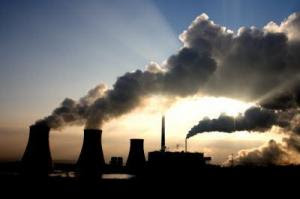NATIONAL GEOPHYISCAL RESEARCH INSTITUTE
(Council of Scientific and Industrial Research)
HYDERABAD-500 007
ADVERTISEMENT No. NGRI- 3/ 2009
National Geophysical Research Institute (NGRI), a premier Research Institute under
Council of Scientific & Industrial Research (CSIR), New Delhi, is involved in
multidisciplinary R & D programmes in different areas of Earth Sciences: Geophysics,
Geology, Geochemistry and Geochronology. Major focal themes of R & D include:
Exploration for Hydrocarbon, Mineral and Groundwater resources, Understanding the Earth’s
Lithosphere and Interior, Geodynamics and Earth’s Environment. It has excellent facilities in
all the above disciplines.
Applications are invited from bright and eligible candidates with excellent academic
record throughout and desirous of taking research in Earth Science as a career for the
following posts:
1. Scientist Gr.IV(3)(Rs.15600-39100 with Grade pay of Rs. 7600/-)(01 Post)(UR).
Upper Age limit: 40 years (as on the last date for receipt of filled in applications).
Post Code : S-1. Discipline: Geology.
Essential Qualifications : First Class M.Sc. / M.Sc.(Tech) in Geology/ Applied Geology
OR M. Tech. in Geology / Applied Geology OR Ph. D. in Geology / Applied Geology.
Job Requirement: To work in a modern isotope geochemical - geochronology lab. To
formulate, acquire and interpret field geological and laboratory data and participate in
integrated Geoscience R&D programs in lithosphere and mineral resources.
Experience : 7 years after M.Sc. or 5 years after M.Tech. or 4 years after Ph.D. Experience
should be in the field of Geological mapping and substantial practical experience in a
modern Geochemical and Geochronological laboratory conversant with TIMS/MC-ICPMS
and Clean Chemistry practices.
02. Scientist Gr.IV(3) (Rs.15600-39100 with Grade pay of Rs.7600/-)(2 posts).
Upper Age limit: 40 years (as on the last date for receipt of filled in applications).
Post Code & Reservation Status:S-2(forUR) & S-3 (for OBC). Discipline: Geophysics.
Essential Qualifications : First Class M.Sc. / M.Sc. (Tech) / M.Tech. in Geophysics/
Exploration Geophysics / Applied Geophysics OR Ph.D. in Geophysics / Applied
Geophysics.
Job Requirement : To plan, acquire, process and interpret Gravity / Magnetic / MT /
electrical / seismic data for hydrocarbon and mineral exploration and to formulate new
research programmes in Exploration Geophysics.
Experience : 7 years after M.Sc. or 5 years after M.Tech. or 4 years after Ph.D. Experience
should be in the field of Gravity / Magnetic / MT / electrical and Seismic exploration (2-D, 3-
D and 4-D)
03. Scientist Gr.IV(3)(Rs.15600-39100 with Grade pay of Rs.7600/-)(1 Post)(UR).
Upper Age limit : 40 years (as on the last date for receipt of filled in applications).
Post Code : S-4. Discipline: Airborne Geophysics.
Essential Qualifications: First Class M.Sc. / M.Sc. (Tech) / M.Tech. in Geophysics /
Exploration Geophysics/ Applied Geophysics OR Ph.D in Geophysics.
Job Requirement: To plan, acquire, process and interpret high resolution airborne
geophysical data for mineral exploration and to formulate and execute new research
programmes in airborne geophysics.
Experience : 7 years after M.Sc. or 5 years after M.Tech. or 4 years after Ph.D. Experience
should be in the field of Airborne geophysics/ electromagnetic methods.
04. Scientist Gr.IV(3) )(Rs.15600-39100 with Grade pay of Rs.7600/-)(1 Post)(for OBC).
Upper Age limit : 40 years (as on the last date for receipt of filled in applications).
Post Code : S-5. Discipline : Rock Magnetism and Paleomagnetism/Rock Mechanics.
Essential Qualifications: First Class M.Sc. / M.Sc.(Tech) / M.Tech or Ph.D. in
Geophysics/ Exploration Geophysics/ Applied Geophysics/Rock Mechanics.
Job Requirement: To develop and maintain a modern rock magnetism and paleomagnetic
laboratory and to formulate and execute new R&D projects in Rock magnetism and Rock
Mechanics
Experience :7 years after M.Sc. or 5 years after M.Tech. or 4 years after Ph.D. Experience
should be in the field of Rock Magentism/Paleomagnetism/ Rock Mechanics.
05. Scientist Gr.IV(3)(Rs.15600-39100 with Grade pay of Rs.7600/-)(1 Post)(for UR).
Upper Age limit : 40 years (as on the last date for receipt of filled in applications).
Post Code : S-6. Discipline : Seismology / Seismic Exploration.
Essential Qualifications: First class M.Sc. / M.Sc. ( Tech ) / M. Tech. in Geophysics /
Exploration Geophysics/ Applied Geophysics OR Ph.D. in Geophysics.
Job Requirement: To plan, acquire, process and interpret Seismological / Seismic data for
land and Sea.
Experience : 07 years experience in relevant field after M.Sc. OR 05 years relevant
experience after M.Tech. OR 04 years relevant experience after Ph.D.
Lady Resident Medical Officer Gr. III(5) (Rs.15600-39100 with Grade Pay of Rs. 6600)
(1 post) (UR) :
Upper Age limit : 40 Years (as on the last date for receipt of filled in applications).
Post Code : LMO-7. Discipline : Medical & Health Services.
Essential Qualifications : MBBS. Desirable: Diploma in Gynaecology / Pediatrics.
Job Requirement : Attending/examining the ailing members of staff and their families in the
Dispensary of the Institute as well as at their residences whenever required and such other allied
duties of the Medical Officer of a dispensary. Attending emergencies during/beyond Office hours and
on holidays. Shall be required to (i) work on Saturdays (ii) stay in NGRI.
Experience : Not less than 5 years experience in a reputed Hospital.
IMPORTANT:
1. Experience should be in the relevant area and according to the job requirement.
2. The age and experience will be reckoned as on the last date prescribed for receipt of completed
application form.
03. The period of experience in a discipline or area of work, where prescribed, shall be counted after
the date of acquiring the minimum prescribed educational qualification for the post.
General conditions:
1. The posts will carry usual allowances as admissible to CSIR employees. Higher initial pay may be
considered in exceptionally meritorious cases. Incumbents are liable to serve anywhere in India or
outside.
2. Relaxations: Relaxation of age to the SC/ST/OBC/PH candidates will be considered against the posts
reserved for their category in accordance with the GOI/CSIR rules as made applicable to them, from time
to time. The SC/ST/OBC candidates who apply for the general vacancies will not be eligible for age
relaxation. (ii) age, qualifications and experience prescribed above can be relaxed in case of exceptionally
meritorious candidates with the prior approval of the Competent Authority.
3. Applications from the candidates working in Govt. Departments/ Public Sector Organizations and Govt.
funded Research Agencies will be considered only if forwarded through proper channel (advance copy of
application should reach before the last date) and with a clear certificate that no vigilance case is pending/
being contemplated against him/her and the applicant will be relieved within one month of receipt of
appointment order.
4. Separate applications should be submitted for each post in the prescribed format indicating clearly the
Advertisement Number, Name of the Post and Post Code, accompanied by separate application fee.
05. Application forms may be obtained from the Controller of Administration, National Geophysical
Research Institute, Uppal Road, Hyderabad-500007 by sending a requisition together with a self
addressed stamped envelope of (23 x 10cm.) bearing postage stamp of Rs.10 (Rupees ten) or in
person on or before 21.09.2009. Requests for application form received after this date will not be
entertained.
06. Application duly filled in and duly supported by attested copies of all relevant certificates including
Community Certificate (in the case of SC/ST/OBCs candidates), certificate of physically handicapped
issued by the competent authority (in case of PH candidates), passport size photograph of the
individual along with a non-refundable application fee of Rs.100/- (Rupees one hundred only) in the
form of D.D. drawn in favour of Director, National Geophysical Research Institute, Hyderabad, valid
at least for 6 months, should be sent so as to reach the Controller of Administration on or before
07.10.2009. SC/ST/PH candidates and regular employees of CSIR are exempted from payment of
application fee.
7. Applications not accompanied by (i)the relevant attested copies of certificates including semister
wise memorandum of marks sheet(s) (ii) Demand Draft and (iii) unsigned & incomplete applications
will be summarily rejected.
8. Incomplete and unsigned applications as well as those received after the last date i.e. 07.10.2009 will not
be considered.
9. Mere fulfilling the essential educational qualifications and experience will not vest any right on a
candidate for being called for interview. The applications will be short-listed and the decision of the
Institute will be final.
10. The candidates called for interview will be paid to and fro single second class rail fare, by shortest direct
route, from the actual place of undertaking the journey or from the place of their residence whichever is
nearer to Secunderabad Railway Station, on production of Bus ticket/rail ticket number, as per GOI/CSIR
Rules.
11. Canvassing in any form, and/or bringing in any influence, political or otherwise, will be treated as a
disqualification for the post.
INTERIM ENQUIRES WILL NOT BE ENTERTAINED.
CONTROLLER OF ADMINISTRATION
****
This advertisement is also available at NGRI Website : www.ngri.org.in






